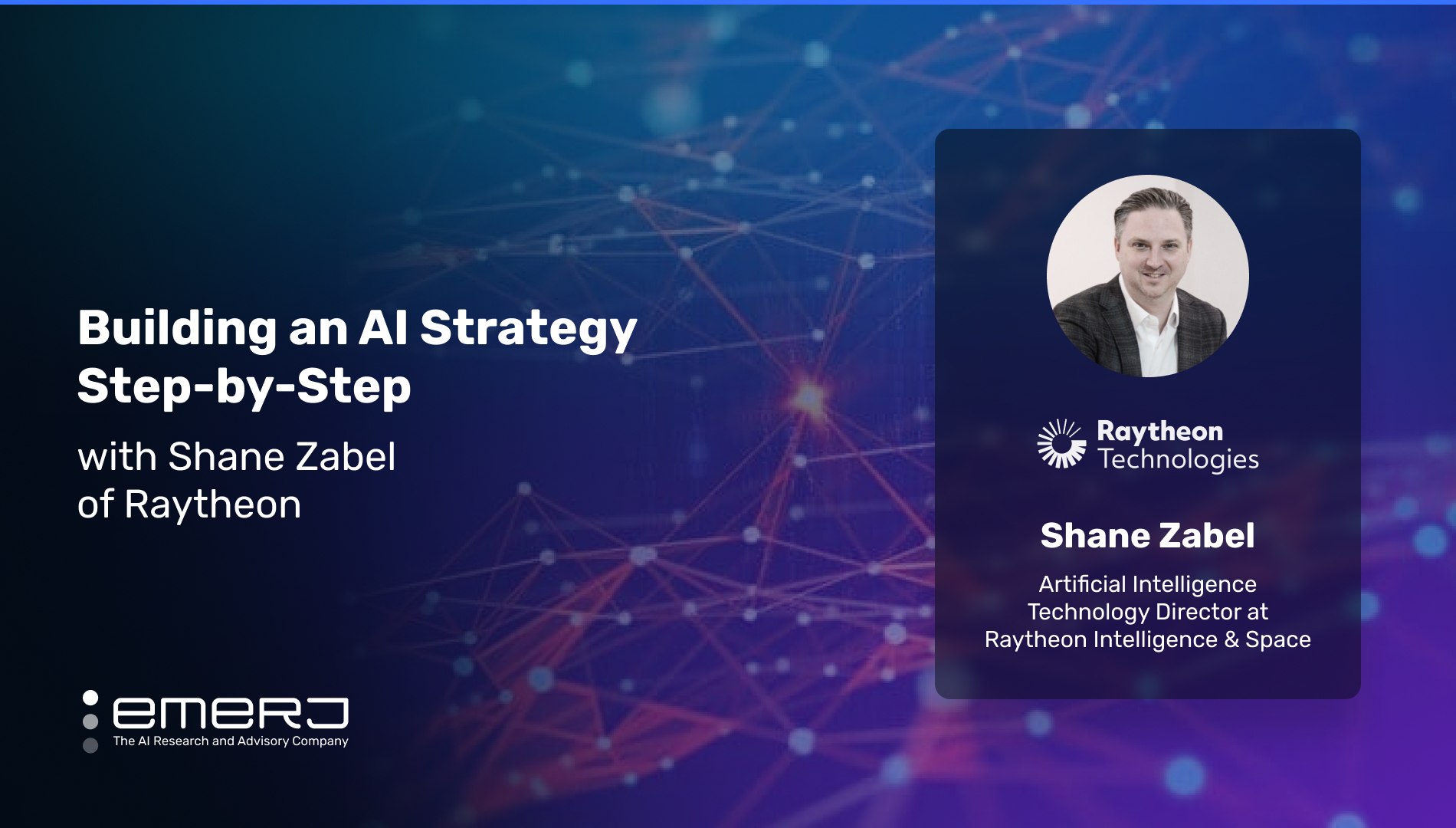What does developing an AI strategy look like? Most executives openly embrace the technology and the automation possibilities within their organization. They may just need a bit of help getting started.
On Emerj’s AI in Business podcast, we regularly extract actionable insights for planning corporate AI strategy from enterprise leaders at some of the largest companies in the global economy. Among our recent distinguished guests on the program is Dr. Shane Zabel, the Head of AI at Raytheon’s Intelligence and Space division. Raytheon is one of the world’s largest aerospace and defense conglomerates, with over 170,000 employees and $64 billion in revenue.
During his appearance, Dr. Zabel discusses a potentially-useful AI strategy idea: having what he calls an “AI pioneer.” The AI Pioneer’s responsibility is to construct initial ideas for potential value-adding use cases, among other tasks we will discuss.
Shane makes it clear at the beginning of the episode that when referring to AI, he generally refers to machine learning, as this was the predominant focus within Raytheon’s own AI strategy at the time.
In his brief conversation with Emerj CEO Daniel Faggella on the podcast, Shane explores how organizations can build a step-by-step AI strategy, focusing on four specific elements:
- A four-step strategy framework for getting started: A framework involving just four steps, Shane’s AI strategy can assist leaders in planning and initial execution.
- Iterative AI planning for scaling: The ever-evolving nature of AI necessitates a “living document” mindset and approach to AI strategy to scale and avoid being left behind.
- The necessity of a use case identification framework for timely execution: As AI knowledge and use expands, rigorous use case identification and selection becomes necessary for proper and timely execution.
- Including multiple stakeholders for AI strategy buy-in: Gain buy-in across the enterprise by seeking stakeholders from the bottom up: from engineers to investors, and in that order. Start with those closest to the task, and involve business leadership with SME-level stakeholders as a way to build authority towards bigger goals.
Listen to the full episode below:
Guest: Dr. Shane Zabel, Head of AI, Raytheon Intelligence and Space
Expertise: Applied cognition, Physics, Machine Learning, Electrical Engineering
Brief Recognition: Prior to becoming Head of AI at Raytheon Intelligence and Space, Dr. Zabel served as Raytheon’s Chief AI officer and Chief Engineer. Dr. Zabel holds an MS and Ph.D. in Physics from Carnegie Mellon and an MS in Applied Cognition and Neuroscience from the University of Texas at Dallas.
A Four-Step AI Strategy Framework for Getting Started
Shane begins the podcast by discussing his approach to AI strategy building at Raytheon. First, he makes it clear that when using the term “AI,” he generally refers to machine learning, as this was the key technology focus at Raytheon at the time.
Shane says that the first step in implementing an AI strategy is to educate on the technology and its potential impact on your organization.
In an executive whitepaper on developing AI strategy authored by Emerj CEO Daniel Faggella and published for our Emerj Plus members, “Developing executive AI fluency” is listed as step one and consists of three fundamental understandings:
- What AI can do
- A reasonable range of use cases
- The Company’s AI Transformation Vision
The second step is discovering potential processes where the company may wish to implement AI. The implementation may be in the form of a workable prototype product or, if you are like most readers, the automation of some business process.
The third step is to find an “AI pioneer” who will lead the development of the initial AI strategy. Such a person will ideally have both a solid business education and a technological understanding of AI and machine learning. We will discuss more about what it means to have an AI Pioneer in a subsequent section of the article.
The last step is to examine your business and where AI fits in closely. Is AI going to be a transformation agent that ushers in a new way of doing things? Or is it more of a supportive technology?
Iterative AI Planning for Scaling
Any AI strategy, because of the emerging, rapidly-evolving nature of the technology, must be looked at as iterative. “Six months, 12 months in the AI technology space brings about a lot of changes,” Zabel tells Emerj.
“I think a good business practice [is to] understand that strategies are living documents and that there’s an iterative approach,” he continues. “Particularly as you get smarter on the AI technology side, that needs to be continuously fed back into your business side.”
In other words, technology and business strategy and going to co-evolve. As more people learn about how AI works — including the sophistication of and opportunities and challenges of AI — this knowledge will naturally find its way into business process improvement or redesign.
Shane makes the critical point of organizations “getting their feet wet” with AI and learning about it. He then drives the final point in the importance of having an iterative AI strategy home:
“If you don’t treat this as kind of an iterative, ongoing, living process, the technology will change out from underneath you, and then you don’t have the best strategy that you could possibly have.”
– Head of AI at Raytheon Intelligence and Space, Dr. Shane Zabel
A Use Case Identification Framework for Timely Execution
Shane asserts that use case identification should be a crucial part of a company’s AI strategy, noting that “Being able to have a repeatable framework from which you can determine which opportunities in the AI and ML space you want to go after and which capabilities you want to develop are important.”
He continues explaining that the trend is particularly true for large organizations because “you can end up with hundreds or thousands of great ideas” for use cases, and without some repeatable framework, prioritizing which use cases to pursue and which to shelf becomes very difficult.
Where smaller organizations can be more agile and intimate with sharing ideas between fewer stakeholders, larger organizations have a tendency to lose ideas in bureaucracy and already existing processes. Shane further explains that such a use case framework requires a cross-disciplinary team from business development, marketing, and engineering and a “profit and loss” (i.e., finance/accounting) team.
Including Multiple Stakeholders for AI Strategy Buy-In
Shane also appears to make few to no disparities between who needs to be involved when deciding on a new initiative- and this includes AI projects:
“I think from a stakeholder perspective, [AI strategy involves] the standard stakeholder alignment associated with any business strategy. You need your profit and loss organizations, your engineering and technology organizations, your leadership team, your investors … they are all stakeholders, and they all have to be bought into it.”
– Head of AI at Raytheon Intelligence and Space, Dr. Shane Zabel
Shane continues by asking and then answering the all-important question: who should drive AI strategy? Who should be that AI Pioneer?
“I think that obviously depends. AI – it’s a technology; it’s very technical. Engineering and your technology organization need to be involved, or somebody who understands the core technology and your profit and loss organizations,” he answers. “Those are the two key stakeholders that I’ve seen.”




















